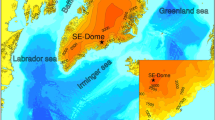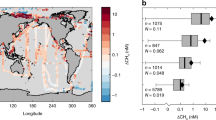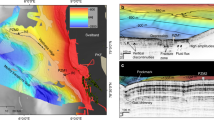Abstract
Uncertainty in the future atmospheric burden of methane, a potent greenhouse gas1, represents an important challenge to the development of realistic climate projections. The Arctic is home to large reservoirs of methane, in the form of permafrost soils and methane hydrates2, which are vulnerable to destabilization in a warming climate. Furthermore, methane is produced in the surface ocean3 and the surface waters of the Arctic Ocean are supersaturated with respect to methane4,5. However, the fate of this oceanic methane is uncertain. Here, we use airborne observations of methane to assess methane efflux from the remote Arctic Ocean, up to latitudes of 82° north. We report layers of increased methane concentrations near the surface ocean, with little or no enhancement in carbon monoxide levels, indicative of a non-combustion source. We further show that high methane concentrations are restricted to areas over open leads and regions with fractional sea-ice cover. Based on the observed gradients in methane concentration, we estimate that sea–air fluxes amount to around 2 mg d−1 m−2, comparable to emissions seen on the Siberian shelf. We suggest that the surface waters of the Arctic Ocean represent a potentially important source of methane, which could prove sensitive to changes in sea-ice cover.
This is a preview of subscription content, access via your institution
Access options
Subscribe to this journal
Receive 12 print issues and online access
$259.00 per year
only $21.58 per issue
Buy this article
- Purchase on Springer Link
- Instant access to full article PDF
Prices may be subject to local taxes which are calculated during checkout



Similar content being viewed by others
References
IPCC Climate Change 2007: The Physical Science Basis (eds Soloman, S. et. al) (Cambridge Univ. Press, 2007).
O’Connor, F. M. et al. Possible role of wetlands, permafrost, and methane hydrates in the methane cycle under future climate change: A review. Rev. Geophys. 48, RG4005 (2010).
Scranton, M. I. & Brewer, P. G. Occurrence of methane in near-surface waters of western subtropical North-Atlantic. Deep-Sea Res. 24, 127–138 (1977).
Damm, E. et al. Methane production in aerobic oligotrophic surface water in the central Arctic Ocean. Biogeosciences 7, 1099–1108 (2010).
Damm, E., Thoms, S., Kattner, G., Beszczynska-Moller, A., Nothig, E. M. & Stimac, I. Coexisting methane and oxygen excesses in nitrate-limited polar water (Fram Strait) during ongoing sea ice melting. Biogeosci. Discuss. 8, 5179–5195 (2011).
Etheridge, D. M., Steele, L. P., Francey, R. J. & Langenfelds, R. L. Atmospheric methane between 1000 AD and present: Evidence of anthropogenic emissions and climatic variability. J. Geophys. Res. 103, 15979–15993 (1998).
Dlugokencky, E. J. et al. Atmospheric methane levels off: Temporary pause or a new steady-state? Geophys. Res. Lett. 30, 1992 (2003).
Rigby, M. et al. Renewed growth of atmospheric methane. Geophys. Res. Lett. 35, L22805 (2008).
Walter, K. M., Zimov, S. A., Chanton, J. P., Verbyla, D. & Chapin, F. S. Methane bubbling from Siberian thaw lakes as a positive feedback to climate warming. Nature 443, 71–75 (2006).
Mastepanov, M. et al. Large tundra methane burst during onset of freezing. Nature 456, 628–658 (2008).
Shakhova, N. et al. Extensive methane venting to the atmosphere from sediments of the east Siberian Arctic shelf. Science 327, 1246–1250 (2010).
Fisher, R. E. et al. Arctic methane sources: Isotopic evidence for atmospheric inputs. Geophys. Res. Lett. 38, L21803 (2011).
Karl, D. M. et al. Aerobic production of methane in the sea. Nature Geosci. 1, 473–478 (2008).
Dlugokencky, E. J. et al. Observational constraints on recent increases in the atmospheric CH4 burden. Geophys. Res. Lett. 36, L18803 (2009).
Bousquet, P. et al. Source attribution of the changes in atmospheric methane for 2006–2008. Atmos. Chem. Phys. 11, 3689–3700 (2011).
Wofsy, S. C. HIAPER Pole-to-Pole Observations (HIPPO): Fine-grained, global-scale measurements of climatically important atmospheric gases and aerosols. Phil. Trans. R. Soc. A 369, 2073–2086 (2011).
Jimenez, R. et al. Atmospheric trace gas measurements using a dual quantum-cascade laser mid-infrared absorption spectrometer. Proc. SPIE 5738, 318–331 (2005).
Kort, E. A. et al. Tropospheric distribution and variability of N2O: Evidence for strong tropical emissions. Geophys. Res. Lett. 38, L15806 (2011).
Proffitt, M. H. & McLaughlin, R. J. Fast-response dual-beam UV-absorption ozone photometer suitable for use on stratospheric balloons. Rev. Scient. Inst. 54, 1719–1728 (1983).
Zondlo, M. A., Paige, M. E., Massick, S. M. & Silver, J. A. Vertical cavity laser hygrometer for the National Science Foundation Gulfstream-V aircraft. J. Geophys. Res. 115, D20309 (2010).
Grumbine, R. W. Automated sea ice concentration analysis at NCEP. Tech. Note 120, 1–13 (1996).
Simpson, W. R. et al. Halogens and their role in polar boundary-layer ozone depletion. Atmos. Chem. Phys. 7, 4375–4418 (2007).
Draxler, R. R. & Rolph, G. D. HYSPLIT (HYbrid Single-Particle Lagrangian Integrated Trajectory) Model Access via NOAA ARL READY Website (NOAA Air Resources Laboratory, 2012), http://ready.arl.noaa.gov/HYSPLIT.php.
Rolph, G. D. Real-time Environmental Applications and Display sYstem (READY) Website (NOAA Air Resources Laboratory, 2012), http://ready.arl.noaa.gov.
Kitidis, V., Upstill-Goddard, R. C. & Anderson, L. G. Methane and nitrous oxide in surface water along the North–West Passage, Arctic Ocean. Marine Chem. 121, 80–86 (2010).
Von Deimling, J. S. et al. Quantification of seep-related methane gas emissions at Tommeliten, North Sea. Cont. Shelf Res. 31, 867–878 (2011).
Anderson, P. S. & Neff, W. D. Boundary layer physics over snow and ice. Atmos. Chem. Phys. 8, 3563–3582 (2008).
Acknowledgements
HIPPO was supported by NSF grants ATM-0628575, ATM-0628519 and ATM-0628388 and by NCAR. NCAR is supported by the NSF. Participation by NOAA instruments were supported in part by the NSF through its Atmospheric Chemistry Program to CIRES, NOAA through its Atmospheric Composition and Climate Program and the Office of Oceanic and Atmospheric Research, and NASA through its Upper Atmosphere Research Program and Radiation Sciences Program. We thank the pilots, mechanics, technicians and scientific crew working on HIPPO. We thank C. Sweeney and D. Fitzjarrald for aiding in interpretation of results and D. Nance for his contributions to H2O observations. The authors gratefully acknowledge the NOAA Air Resources Laboratory for the provision of the HYSPLIT transport and dispersion model and READY website (http://www.arl.noaa.gov/ready.php) used in this publication.
Author information
Authors and Affiliations
Contributions
E.A.K. collected the CH4 data, noted the Arctic features, carried out analysis and wrote the manuscript. S.C.W. led the HIPPO campaign and guided both analysis and writing. B.C.D. and R.J. collected CH4 data. R.S.G. and J.R.S. collected O3 data. M.D., J.W.E., E.J.H., D.F.H., F.L.M and M.A.Z. collected water vapour data. All authors discussed results and commented on the manuscript.
Corresponding author
Ethics declarations
Competing interests
The authors declare no competing financial interests.
Supplementary information
Supplementary Information
Supplementary Information (PDF 1064 kb)
Rights and permissions
About this article
Cite this article
Kort, E., Wofsy, S., Daube, B. et al. Atmospheric observations of Arctic Ocean methane emissions up to 82° north. Nature Geosci 5, 318–321 (2012). https://doi.org/10.1038/ngeo1452
Received:
Accepted:
Published:
Issue Date:
DOI: https://doi.org/10.1038/ngeo1452
This article is cited by
-
Nitrous oxide and methane in a changing Arctic Ocean
Ambio (2022)
-
The future of Arctic sea-ice biogeochemistry and ice-associated ecosystems
Nature Climate Change (2020)
-
Tracing the climate signal: mitigation of anthropogenic methane emissions can outweigh a large Arctic natural emission increase
Scientific Reports (2019)
-
The Transpolar Drift conveys methane from the Siberian Shelf to the central Arctic Ocean
Scientific Reports (2018)
-
Observation of atmospheric methane in the Arctic Ocean up to 87° north
Science China Earth Sciences (2017)



